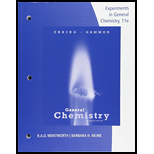
Concept explainers
Interpretation:
Distribution of d-electrons in the complex ion
Concept Introduction:
The term Crystal field splitting refers to segregation of d-orbitals in to higher energy orbitals and lower energy orbitals when ligands approaches metal ion to co-ordinate. Crystal field splitting is said to be larger when the energy gap between higher energy d-orbitals and lower energy d-orbitals is larger. Crystal field splitting is said to be smaller when the energy gap between higher energy d-orbitals and lower energy d-orbitals is smaller.
Spectrochemical series refers to the arrangement of ligands with respect to crystal field splitting they cause in the d-orbitals of a metal ion. The ligand that causes larger splitting pattern is referred to as stronger ligand.
The ligands are arranged in increasing order of crystal field splitting they produce.
The ligand that causes larger crystal field splitting is strong ligand and the ligand that causes smaller splitting is termed as weak ligand.
Pairing energy refers to the energy required to pair the electrons - that is energy required to make two electrons to be paired in same orbital with opposite spins.
If the pairing energy of a complex is high it means the electrons are difficult to be paired and so the complex will be high spin complex with unpaired electrons. If the pairing energy of a complex is low it means the electrons are readily paired and so the complex will be low spin complex with paired electrons.
A complex with high splitting energy will have low pairing energy because high splitting energy indicates larger energy gap between lower and higher energy levels that the electrons need lesser energy to be paired and they tend to remain paired in lower energy orbitals. A complex with low splitting energy will have high pairing energy because low splitting energy indicates smaller energy gap between lower and higher energy levels that the electrons disperse among orbitals more randomly and they need higher energy to be paired.
Want to see the full answer?
Check out a sample textbook solution
Chapter 22 Solutions
Lab Manual Experiments in General Chemistry
- Curved arrows are used to illustrate the flow of electrons. Using the provided starting and product structures, draw the curved electrons-pushing arrows for the following reaction or mechanistic step(s).arrow_forwardCurved arrows are used to illustrate the flow of electrons. Using the provided starting and product structures, draw the curved electron-pushing arrows for the following reaction or mechanistic step(s). Be sure to account for all bond-breaking and bond-making steps. I I I H Select to Add Arrows HCI, CH3CH2OHarrow_forwardCurved arrows are used to illustrate the flow of electrons. Use the reaction conditions provided and the follow the arrows to draw the intermediate and product in this reaction or mechanistic step(s).arrow_forward
- Curved arrows are used to illustrate the flow of electrons. Use the reaction conditions provided and follow the curved arrows to draw the intermediates and product of the following reaction or mechanistic step(s).arrow_forwardCurved arrows are used to illustrate the flow of electrons. Use the reaction conditions provided and follow the arrows to draw the intermediate and the product in this reaction or mechanistic step(s).arrow_forwardLook at the following pairs of structures carefully to identify them as representing a) completely different compounds, b) compounds that are structural isomers of each other, c) compounds that are geometric isomers of each other, d) conformers of the same compound (part of structure rotated around a single bond) or e) the same structure.arrow_forward
- Given 10.0 g of NaOH, what volume of a 0.100 M solution of H2SO4 would be required to exactly react all the NaOH?arrow_forward3.50 g of Li are combined with 3.50 g of N2. What is the maximum mass of Li3N that can be produced? 6 Li + N2 ---> 2 Li3Narrow_forward3.50 g of Li are combined with 3.50 g of N2. What is the maximum mass of Li3N that can be produced? 6 Li + N2 ---> 2 Li3Narrow_forward
- Concentration Trial1 Concentration of iodide solution (mA) 255.8 Concentration of thiosulfate solution (mM) 47.0 Concentration of hydrogen peroxide solution (mM) 110.1 Temperature of iodide solution ('C) 25.0 Volume of iodide solution (1) used (mL) 10.0 Volume of thiosulfate solution (5:03) used (mL) Volume of DI water used (mL) Volume of hydrogen peroxide solution (H₂O₂) used (mL) 1.0 2.5 7.5 Time (s) 16.9 Dark blue Observations Initial concentration of iodide in reaction (mA) Initial concentration of thiosulfate in reaction (mA) Initial concentration of hydrogen peroxide in reaction (mA) Initial Rate (mA's)arrow_forwardDraw the condensed or line-angle structure for an alkene with the formula C5H10. Note: Avoid selecting cis-/trans- isomers in this exercise. Draw two additional condensed or line-angle structures for alkenes with the formula C5H10. Record the name of the isomers in Data Table 1. Repeat steps for 2 cyclic isomers of C5H10arrow_forwardExplain why the following names of the structures are incorrect. CH2CH3 CH3-C=CH-CH2-CH3 a. 2-ethyl-2-pentene CH3 | CH3-CH-CH2-CH=CH2 b. 2-methyl-4-pentenearrow_forward
 Chemistry: The Molecular ScienceChemistryISBN:9781285199047Author:John W. Moore, Conrad L. StanitskiPublisher:Cengage Learning
Chemistry: The Molecular ScienceChemistryISBN:9781285199047Author:John W. Moore, Conrad L. StanitskiPublisher:Cengage Learning
